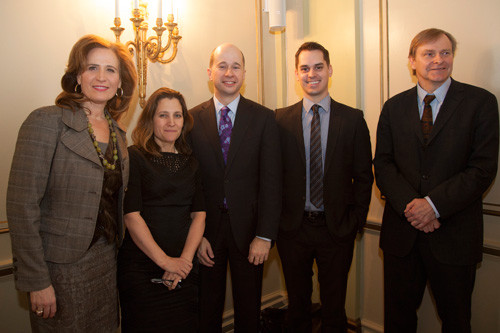November 3, 2015
CHRYSTIA FREELAND ON ECON. PROJECTIONS
By Colin Lynch (Rapporteur for the meeting)

The Canadian Centre launched its 2014 calendar with an economic forecast breakfast in Toronto on January 23, 2014.
Panelists included
Chrystia Freeland (MP, Toronto Centre),
Kim Jarvi (Senior Economist, Registered Nurses Association of Ontario),
Liam McGuinty (Senior Policy Analyst, Ontario Chamber of Commerce)
Derek Holt (Vice President, Scotiabank Economics).
Overall, panelists agreed that while 2014 looks economically brighter than 2013 for Canada, several trends would color this perspective, the most notable being a continued weakening of the Canadian dollar toward the $0.80-$0.82 per USD range which will ultimately help Ontario and Canadian exporters.
Introductory Remarks
Chrystia Freeland began the panel by noting two major trends: the first is the perception of Canada’s relatively strong financial standing will be weakened as the US recovery takes hold. The second is that the United States will increasingly become a producer of energy, thus diminishing the need for Canadian energy imports. She also added that CEOs’ confidence in the economy remains stronger than individual experiences in the job market.
Derek Holt continued with a brighter outlook and noted that Canada’s expected return to fiscal surplus combined with its stable financial system will moderate expected negative tailwinds associated with high consumer indebtedness and inflation adjusted consumer spending.
Kim Jarvi expressed concern that the average duration of unemployment is growing while Canadian government revenues and expenditures are dropping, thus creating negative tailwinds. He noted that Canada’s benchmark interest rate (1%) is out of step with the US (0.25%); a concern given that monetary policy is the most powerful tool in a flexible exchange rate regime.
Liam McGuinty concluded with a regional and sector perspective and noted that while regions such as Toronto and Kitchener-Waterloo are buoyed by strong confidence in select sectors (such as financial services) resource industries in other regions are performing poorer than expected, creating negative tailwinds for those regions. Liam also noted an overall trend toward substituting previously full-time positions with contract positions.
Discussion
A lively discussion then ensued with panelists receiving questions from and engaging in dialogue with guests.
Income distribution – “the 1%”
Chystia Freeland noted that Canada is where the US was in the 1990s, though trending towards a less equal society. She’s troubled by ‘what happens when you make all of the right choices and still fall into the hollowing out middle class’. Kim noted that income distribution is an issue and tax income has failed to narrow the gap; further modifications should be made to Free Trade Agreements to improve fairness. Derek pointed to two often overlooked realities: that the wealthy are often quite successful at keeping networks and job opportunities open. Further, inheritances have substantially increased over the past several decades. Derek noted that even though Canadian underemployment in is much lower than in the US, business leaders are strongly in support of progressive moves to close the province’s infrastructure gap, fund transportation improvements and increase the minimum wage.
Pensions
Derek pointed to several positives: several difficult choices in the mid 1990s have transformed the CPPIB into a world leading pension plan that holds substantial ownership positions in companies globally.
Two Further Downside risks
Derek noted that the Canadian housing market is increasingly off-cycle relative to the US. Further, the Canadian dollar is relatively unknown in many countries; as a result, central bank and foreign currency managers might be prone to dump the Canadian dollars at a fast pace if the dollar continues to fall – thus creating further downside risks.
Conclusion
Freeland concluded with two remarks. As Canadians, we should not simply continue to compare ourselves simply to Americans. We should compare ourselves with the countries that we aspire to (for instance, Canadians shouldn’t feel smug because Canadian income inequality is lower than in the USA).
Secondly, right wing think tanks have successfully portrayed government employees as non-value adding bureaucrats. In reality, government employees are teachers, doctors, nurses, service providers and other professionals that directly contribute to the economy.
Colin Lynch, Advisory Board member



